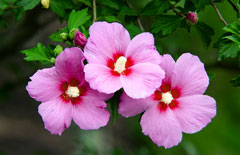The National Flag of Korea |
The Korean flag (태극기) is called "Taegeukgi" in Korean. Its design symbolizes the principles of the yin and yang in Oriental philosophy. The circle in the center of the Korean flag is divided into two equal parts. The upper red section represents the proactive cosmic forces of the yang. Conversely, the lower blue section represents the responsive cosmic forces of the yin. The two forces together embody the concepts of continual movement, balance and harmony that characterize the sphere of infinity. The circle is surrounded by four trigrams, one in each corner. Each trigram symbolizes one of the four universal elements: heaven ( ), earth ( ), earth ( ), fire ( ), fire ( ), and water ( ), and water ( ). ).
|
 |
The National Flower of Korea |
The national flower of Korea is the mugunghwa (무궁화), rose of sharon. Every year from July to October, a profusion of mugunghwa blossoms graces the entire country. Unlike most flowers, the mugunghwa is remarkably tenacious and able to withstand both blight and insects. The flower’s symbolic significance stems from the Korean word mugung, meaning immortality. This word accurately reflects the enduring nature of Korean culture, and the determination and perseverance of the Korean people.
|
 |
|
The National Anthem of Korea |
Korea's national anthem is "Aegukga," which means "Love the Country." In 1896, the Dongnip Sinmun (Independence News) published various versions of lyrics for this song. It is not known exactly what music they were sung to in the early days. Records show that a Western-style military band was formed during the time of the Dae-han Empire (1897-1910) and that the "Dae-han Empire Aegukga" was composed in 1902 and played at important national functions.
The original words of Aegukga appeared in written form around 1907 to inculcate allegiance to the nation and foster the spirit of independence as the country faced threats of foreign annexation. Over the years, the lyrics went through several versions until they were adopted as the national anthem in the present form in 1948.
Before the birth of the Republic in 1948, the words were often sung to the tune of the Scottish folk song, Auld Lang Syne. Maestro Ahn Eak-tay (1905-1965), then living in Spain, felt that it was inappropriate to sing this patriotic song to the tune of another country's folk song. So, he composed new music to go with the lyrics in 1935, and the Korean Provisional Government in exile adopted it as the national anthem. While Koreans outside the country sang the anthem to the new tune, those at home continued to use Auld Lang Syne until Korea was liberated in 1945.
In 1948 the government of the Republic of Korea officially adopted the new version as the national anthem and began to use it at all schools and official functions.
|
|
|
Hangeul - Korea’s Official Alphabet |
Hangeul (한글), Korea’s official alphabet, was first invented by King Sejong during the Joseon Dynasty. Originally called Hunminjeongeum (훈민정음), the language was conceived in 1443, and further promulgated by the King in 1446. At the time of its inception, the language consisted of 17 consonants and 11 vowels however, since then, 3 of the originally established consonants and 1 vowel have fallen into disuse bringing the total number of characters to 24. Syllables are formed by the selective combination of vowels and consonants to create words.
The official name for the Korean language was changed to 'Hangeul' in 1910. Hunminjeongeum Proclamation Day was called ‘Gagya Proclamation Day’ up until 1926, and it wasn’t until 1928 that it was changed to its current title, ‘Hangeul Proclamation Day’.
The chart below represents the 24 Hangeul characters together with their romanized equivalents. 'The Hunminjeongeum,' a historical document which provides instructions to educate people on the use of Hangeul, is registered with UNESCO. UNESCO awards a 'King Sejong Literacy Prize,' every year in memory of the inventor of Hangeul.
|
| Consonants |
| ㄱ |
g, k |
ㅂ |
b, p |
ㅋ |
k |
| ㄴ |
n |
ㅅ |
S |
ㅌ |
T |
| ㄷ |
d, t |
ㅇ |
ng, silent |
ㅍ |
p |
| ㄹ |
r, l |
ㅈ |
J |
ㅎ |
h |
| ㅁ |
m |
ㅊ |
ch |
|
|
| Vowels |
| ㅏ |
a |
ㅗ |
o |
ㅠ |
yu |
| ㅑ |
ya |
ㅛ |
yo |
ㅡ |
eu |
| ㅓ |
eo |
ㅜ |
u |
ㅣ |
i |
| ㅕ |
yeo |
|
|
|
|
|
|
|
|
|
|
